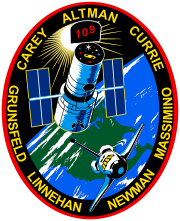STS-109

Hubble in Columbia's payload bay towards the end of the mission
|
|
| Mission type | Hubble servicing |
|---|---|
| Operator | NASA |
| COSPAR ID | 2002-010A |
| SATCAT № | 27388 |
| Mission duration | 10 days, 22 hours, 11 minutes, 09 seconds |
| Distance travelled | 6,300,000 kilometres (3,900,000 mi) |
| Orbits completed | 165 |
| Spacecraft properties | |
| Spacecraft | Space Shuttle Columbia |
| Launch mass | 116,989 kg (257,917 lb) |
| Landing mass | 100,564 kg (221,706 lb) |
| Crew | |
| Crew size | 7 |
| Members |
Scott D. Altman Duane G. Carey John M. Grunsfeld Nancy J. Currie Richard M. Linnehan James H. Newman Michael J. Massimino |
| Start of mission | |
| Launch date | 1 March 2002 11:22:02 UTC |
| Launch site | Kennedy LC-39A |
| End of mission | |
| Landing date | 12 March 2002 09:33:10 UTC |
| Landing site | Kennedy SLF Runway 33 |
| Orbital parameters | |
| Reference system | Geocentric |
| Regime | Low Earth |
| Perigee | 486 km (302 mi) |
| Apogee | 578 km (359 mi) |
| Inclination | 28.5 degrees |
| Period | 95.3 minutes |
 (L-R): Michael J. Massimino, Richard M. Linnehan, Duane G. Carey, Scott D. Altman, Nancy J. Currie, John M. Grunsfeld and James H. Newman. |
|
STS-109 (SM3B) was a Space Shuttle mission that launched from the Kennedy Space Center on 1 March 2002. It was the 108th mission of the Space Shuttle program, the 27th flight of the orbiter Columbia and the fourth servicing of the Hubble Space Telescope. It was also the last successful mission of the orbiter Columbia before the ill-fated STS-107 mission, which culminated in the Columbia disaster.
The Hubble Space Telescope (HST) was placed in orbit during mission STS-31 on 25 April 1990. Initially designed to operate for 15 years, plans for periodic service and refurbishment were incorporated into its mission from the start. After the successful completion of the second planned service mission (SM2) by the crew of STS-82 in February 1997, three of HST's six gyroscopes failed. NASA decided to split the third planned service mission into two parts, SM3A and SM3B. A fifth and final servicing mission, STS-125 (SM4) launched 11 May 2009 The work performed during SM4 is expected to keep HST in operation through 2014.
The purpose of STS-109 was to service the Hubble Space Telescope (HST). It was Columbia's first flight following an extensive two and a half year modification period (its most recent mission being STS-93). During the mission the crew installed a new science instrument, the Advanced Camera for Surveys (ACS), new rigid solar arrays (SA3), a new Power Control Unit (PCU) and an experimental cryocooler for the Near Infrared Camera and Multi-Object Spectrometer (NICMOS). Columbia also reboosted HST to a higher orbit.
...
Wikipedia

